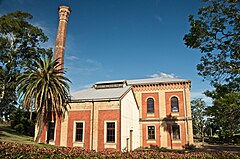Walka Water Works
| Walka Water Works | |
|---|---|

The pump house and smoke stack
|
|
| General information | |
| Architectural style | Victorian Italianate |
| Location | Oakhampton Heights |
| Address | 55 Scobies Lane Oakhampton Heights NSW 2320 |
| Town or city | Maitland, New South Wales |
| Country | Australia |
| Coordinates | 32°42′54.6″S 151°33′8.7″E / 32.715167°S 151.552417°ECoordinates: 32°42′54.6″S 151°33′8.7″E / 32.715167°S 151.552417°E |
| Construction started | 1882 |
| Completed | 1887 |
| Cost | £170,000 |
| Client | Government of New South Wales |
| Technical details | |
| Structural system | Brick |
Walka Water Works is a 19th-century pumping station located near Maitland, New South Wales, Australia. Originally built in 1887 to supply water to Newcastle and the lower Hunter Valley, it has since been restored and preserved and is part of Maitland City Council's Walka Recreation and Wildlife Reserve.
During the early 1880s, with a growing population in Newcastle, the NSW Government commenced construction of the Walka Waterworks to provide a safer water supply to the Newcastle, Maitland, Morpeth and Cessnock districts than existing storage tanks, creeks and boreholes. It was largely complete by 1887 at a cost of £170,000.
The design for the complex was undertaken by notable English engineer Sir William Clark and was a major engineering project for the area at the time. Water was pumped from the Hunter River to a reservoir along a brick tunnel approximately 6 feet (1.8 m) in diameter and 9 metres (30 ft) below ground. At full operation, it had three pumping engines (150 hp each and with a flywheel weighing 36 tonnes), two horizontal compound pumps and a triple expansion surface condensing pump engine. Water would be pumped from the river at Oakhampton up to the Walka reservoir (still visible as the Walka lake today), then pumped onwards to another reservoir 6 miles (9.7 km) away at Buttai; where it was "gravitationally distributed".
At peak operation the waterworks produced 3843 megalitres (in 1915). As the population of the area continued to increase, alterations and additions were made to the system until 1913, when other sources of supply were developed - namely Chichester Dam near Dungog. From 1923 to 1940 the waterworks were used as a backup water supply only.
...
Wikipedia
